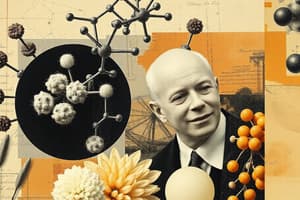Podcast
Questions and Answers
Dehydration synthesis leads to the formation of:
Dehydration synthesis leads to the formation of:
- Proteins and amino acids
- Fatty acids and glycerol
- Nucleotides and nucleic acids
- Waters and polymers (correct)
What reaction takes place during the breakdown of polymers?
What reaction takes place during the breakdown of polymers?
hydrolysis
Which is an example of a monosaccharide?
Which is an example of a monosaccharide?
- Glucose
- Fructose
- Galactose
- All of the above (correct)
Cellulose and starch are examples of:
Cellulose and starch are examples of:
Plant cell walls contain which of the following in abundance?
Plant cell walls contain which of the following in abundance?
Lactose is a disaccharide formed by the formation of a _____ bond between glucose and _____.
Lactose is a disaccharide formed by the formation of a _____ bond between glucose and _____.
Saturated fats tend to dissolve easily in water.
Saturated fats tend to dissolve easily in water.
Phospholipids are important components of:
Phospholipids are important components of:
Monomers that make up proteins are called:
Monomers that make up proteins are called:
The alpha helix and beta pleated sheet are part of which protein structure?
The alpha helix and beta pleated sheet are part of which protein structure?
Nucleotide of DNA may contain:
Nucleotide of DNA may contain:
The building blocks of nucleic acids are:
The building blocks of nucleic acids are:
Why are biological macromolecules organic?
Why are biological macromolecules organic?
What role do electrons play in dehydration synthesis and hydrolysis?
What role do electrons play in dehydration synthesis and hydrolysis?
Why is it impossible for humans to digest food that contains cellulose?
Why is it impossible for humans to digest food that contains cellulose?
What are the functions of lipids?
What are the functions of lipids?
If one amino acid is substituted for another in a polypeptide chain:
If one amino acid is substituted for another in a polypeptide chain:
Flashcards are hidden until you start studying
Study Notes
Carbohydrates
- Dehydration synthesis forms waters and polymers.
- Hydrolysis is the reaction that occurs during polymer breakdown.
- Examples of monosaccharides include glucose, fructose, and others collectively.
- Cellulose and starch are types of polysaccharides.
- Plant cell walls are abundant in cellulose.
Lipids
- Saturated fats do not easily dissolve in water.
- Phospholipids are key components of the plasma membrane.
- Functions of lipids include long-term energy storage, insulation, and serving as building blocks for hormones.
Proteins
- Monomers of proteins are called amino acids.
- Secondary protein structure includes a-helices and b-pleated sheets.
- Substituting one amino acid in a polypeptide can lead to changes in protein structure and function.
Nucleic Acids
- DNA nucleotides consist of deoxyribose, thymine, and a phosphate group.
- Nucleotides are the building blocks of nucleic acids.
Biological Macromolecules
- Biological macromolecules are classified as organic because they contain carbon.
- During dehydration synthesis, monomers share electrons to form covalent bonds.
- Humans cannot digest cellulose due to unbranched chains of glucose monomers.
Studying That Suits You
Use AI to generate personalized quizzes and flashcards to suit your learning preferences.




